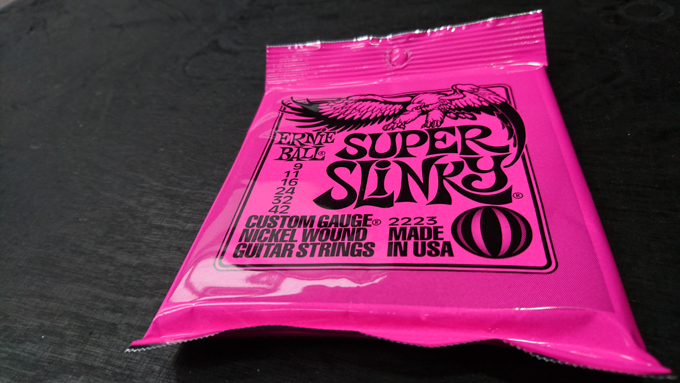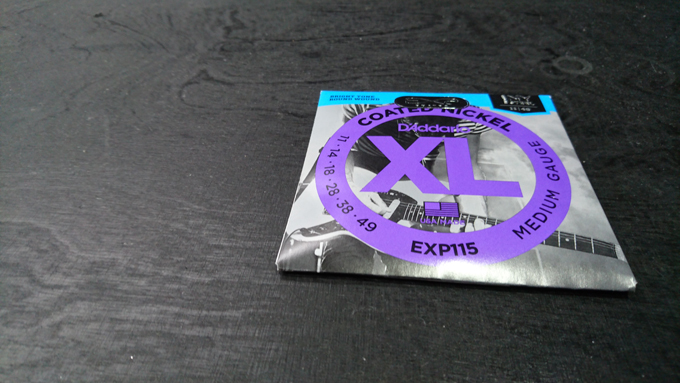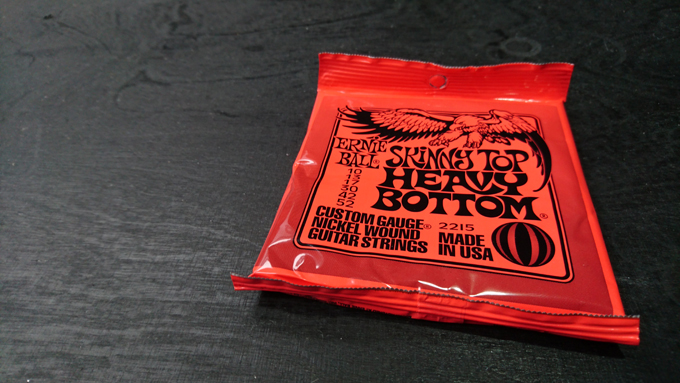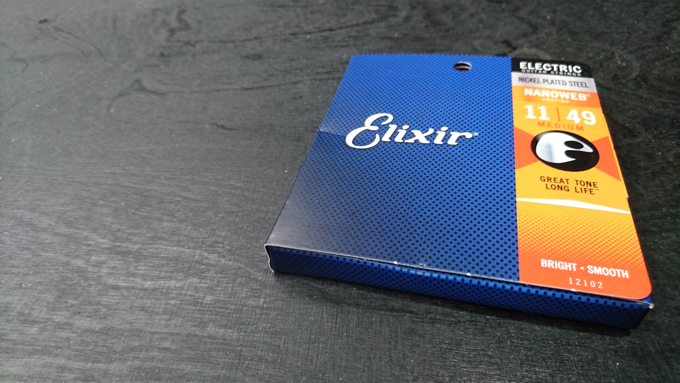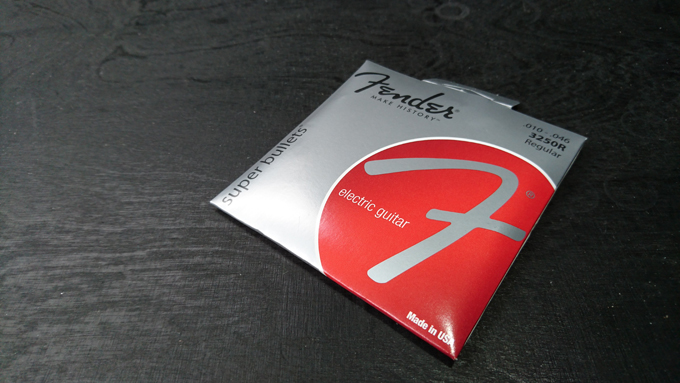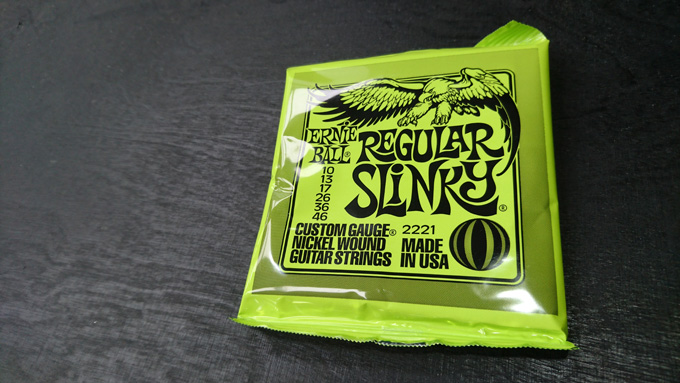Guide to Choosing Electric Guitar Strings
Posted on Wed 28 June 2017 in entries
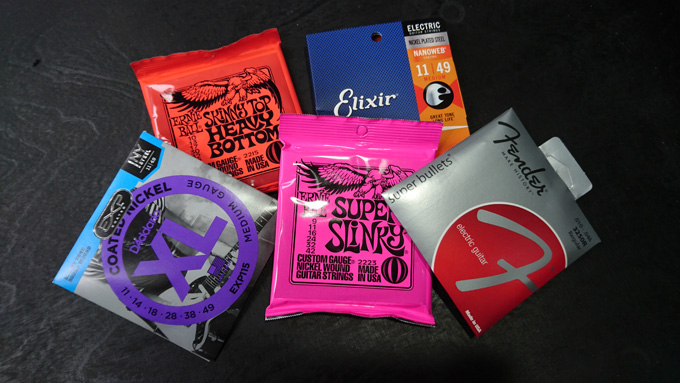
With around 80 different types of electric guitar strings to choose from, with various brands, gauges, materials, coatings etc, it can be a bit daunting choosing the right strings for your electric guitar. So, let’s break it down for you and try to keep it simple.
Are you thick or thin?
When you look at a packet of guitar strings, one of the first things you will see is some numbers, usually something like 9-42, 10-46, 11-49 etc. These are the gauges (or thickness) of the strings from the thin, high E, string to the thick, low E (presuming you’re using standard tuning). Lighter gauges (for example the Ernie Ball Super Slinkys - 9-42) are generally easier for beginners because they are easier to bend and aren’t as harsh on finger tips. Some vintage guitar players prefer lighter strings, not only for note-bending, but also for the bright tone that they produce and they exert less tension on the neck.
Heavy gauge guitar strings (eg. D'Addario EXL115 Nickel Wound 11-49) are noticeably thicker and require more effort from the player to bend and fret the notes. However, because there is more metal in the string, they produce a higher level of sound output, which often suits rock players that use distortion or overdrive pedals. Thicker strings are also preferred by players that ‘drop tune’ their guitar to lower notes than normal, as the heavier gauges respond better to the lower notes and are more stable.
Before we move on from gauges, it’s worth quickly mentioning that you will sometimes see ‘hybrid sets’ such as Ernie Ball Skinny Top Heavy Bottom. These are a bit of a ‘best of both’ solution for many players because the higher strings are thin gauge, making them good for soloing and bending etc, but the lower strings are heavier than normal, making them good for beefy low-end riffs and power chords.
So, in a nutshell...light gauge strings are the go-to choice for beginners and vintage players looking for bright and sparkly clean tones. Heavy gauge strings are for more suited to rock and blues players looking for a thicker and more ‘meaty’ sound.
What Are You Made Of?
Most electric guitar strings are made of nickel-plated steel, and generally this will suit 90-95% of guitar players, and you will only need to stray away from this if you are looking for a very specific tone or characteristic, for example some jazz and blues guitarists swear by Chrome strings because they sound ‘warmer’ and have less of a brightness to them. On the other end of the scale, you could go for stainless steel strings for a bright and crisp tone and because they are stainless steel, they are less prone to corrosion than other options.
In the last few years some of the major string manufacturers have been competing to make their strings stronger and less prone to breakage, with D’addario, Ernie Ball and Elixir all bringing out ranges that claim to be stronger than ever.
Get Your Coat
You might also come across the terms ‘coated’ and ‘uncoated’. Perhaps the most notable example of coated strings are made by Elixir, these promise longer tone-life as the strings are more protected from corrosion than uncoated strings. However, some players are put off of coated strings because of how they feel on the fingertips, which has been likened to the smooth feel of nylon strings.
This is a wind up
The vast majority of strings are ‘wound’, meaning that the thickest 4 strings in the set will have a winding wire wrapped around their core, the most popular type of winding is ‘round wound’ (as found on Ernie Ball strings)which has a ridged texture (this is what makes that scraping sound if you run the edge of a plectrum along a string). Because of their texture they are responsible for a lot of wear on the frets and fretboard, they do however provide the best response and colourful tone.
Alternatively, you could choose ‘flat wound’ strings. These are not easy to come by because they are a bit of a niche product, usually only used by jazz players and give a darker tone and, as the name suggests, have a very smooth feel to them. Sitting half-way between these two options is the suitably-called ‘half wounds’, which have a smoother feel than round wounds but better attack than flat wounds.
How often?
That magical golden question...'How often should I change my strings?'. This is a question that only you can answer, because it depends on so many variables, such as frequency of playing, how and where you store the guitar, type of strings and, dare we say it, how much you sweat onto the strings (Bruce 'the boss' Springsteen changes his strings most nights!). Generally, if you are rehearsing once a week, gigging once a week and look after the guitar, you might expect to change your strings once every 2 months. But if you only play occasionally at home, and keep your guitar in its case when not in use, this can probably be reduced to once every 4 months. You can often tell when they are due a change because they become dull, not just to look at but also in their tone.
Conclusion
Hopefully this has been a handy, and easy to understand, whistle-stop tour of guitar strings. As a general rule of thumb, nickel-wound strings around 10-46 gauge (Ernie Ball Regular Slinkys are one of the best selling sets here at Absolute Music) will suit many players, especially to begin with and then progress from there depending on your style and ability. Go lighter for easier playing or heavier for more beefy tones and to get the most out of distortion pedals.
If you do opt to change string gauges, it is important to check the intonation to make sure that the tuning stays consistent all the way up the neck. We have an in-house guitar workshop here that will help you find the best guitar strings to suit you and will change the strings for you.
